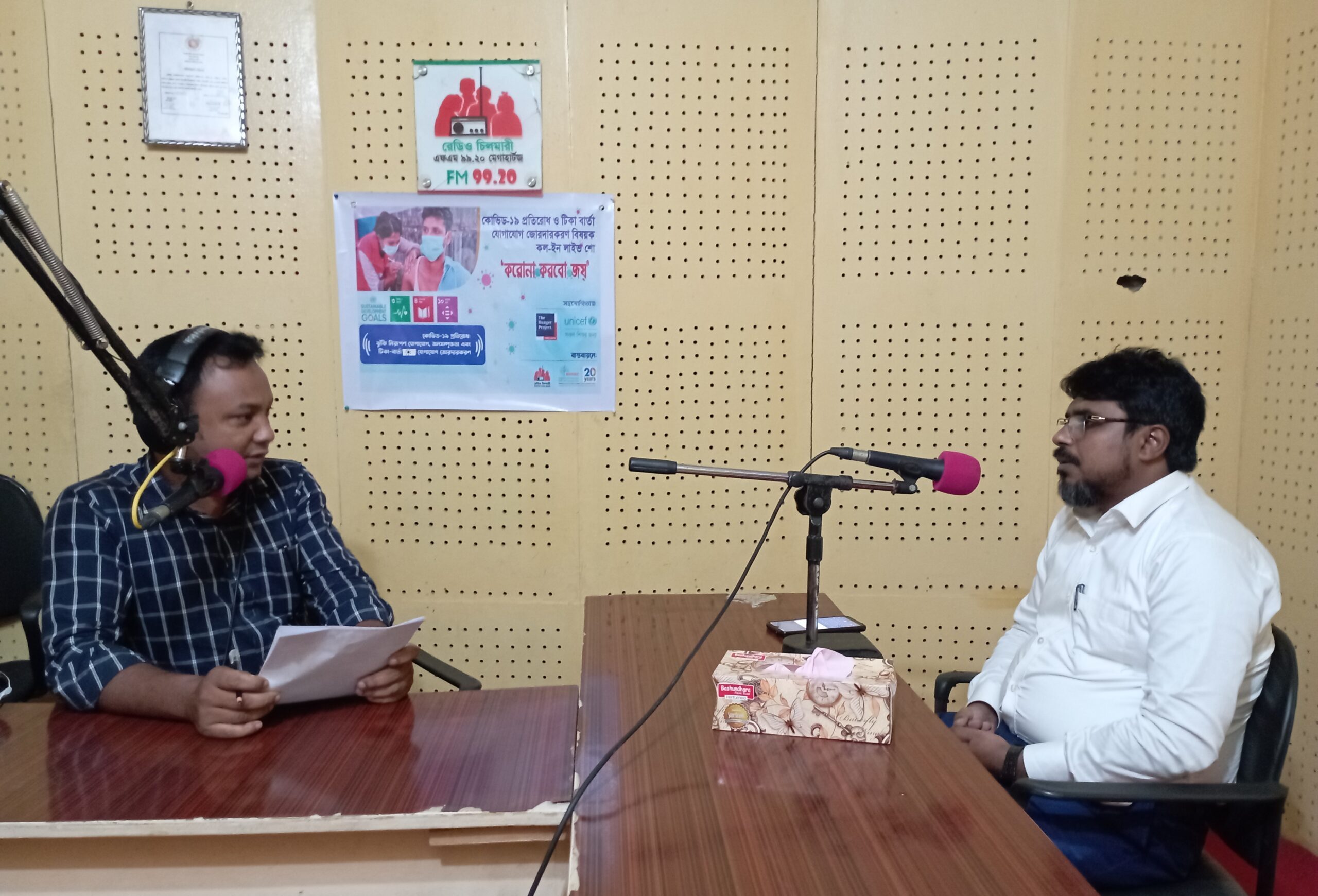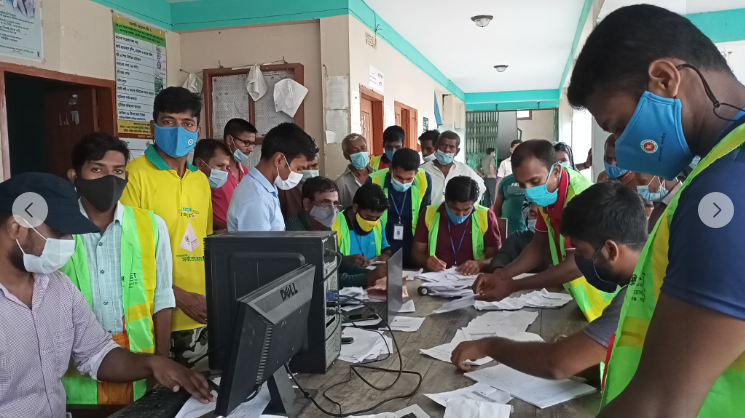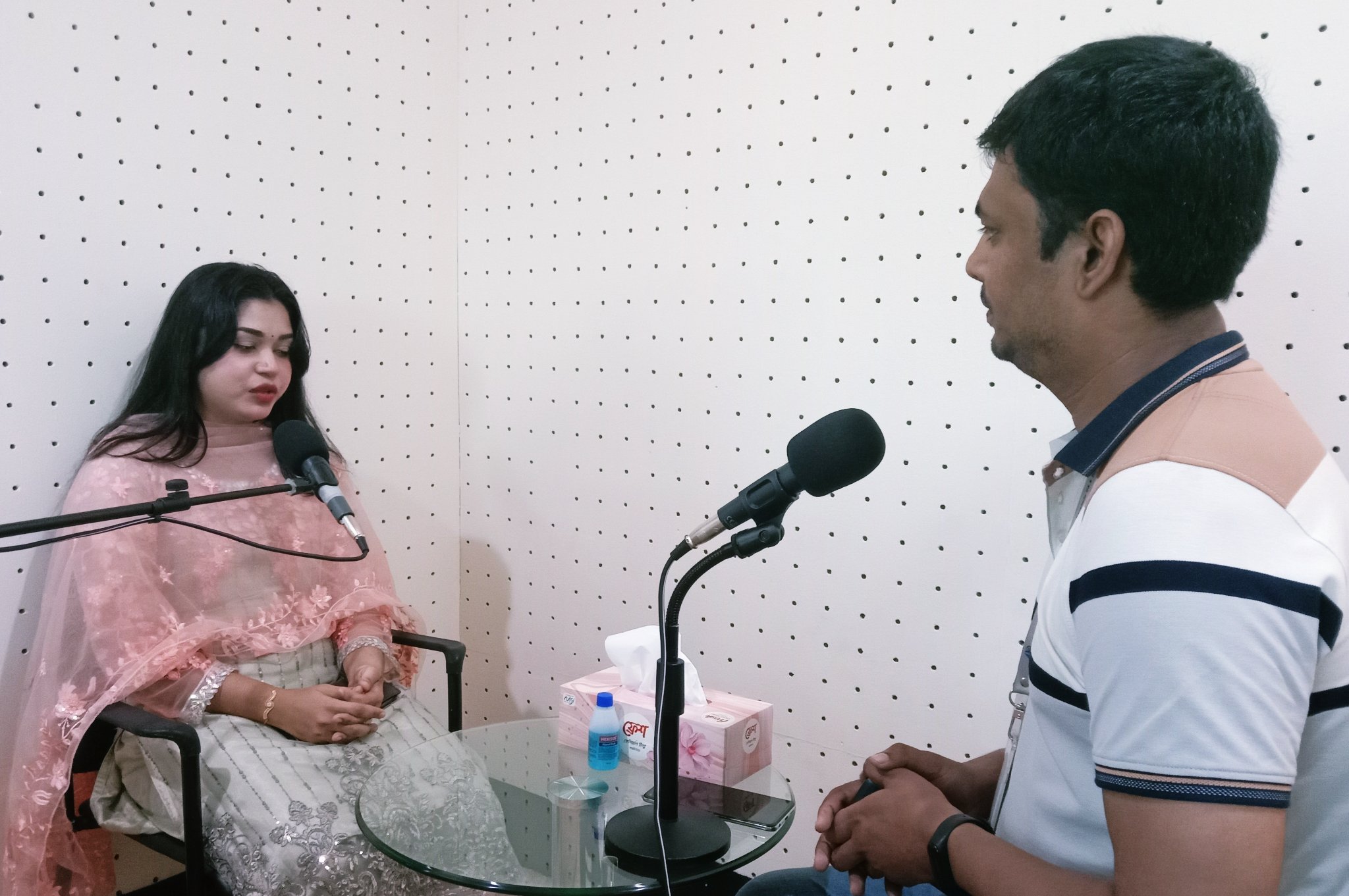Project Description
According to the National Vaccine Deployment Plan (NVDP), the government has targeted to bring 80% of the population under vaccination. All people above the age of 5, including the front-line health care providers, are to be vaccinated. The proposed project will initiate advocacy both at the national and local levels to promote vaccines, thus creating an enabling environment where the general mass is encouraged to complete all the doses.
BNNRC has implemented the project covering 22 geographical districts including the hard-hit areas and underserved and vulnerable communities.
The goal of the project
Prevent the pandemic COVID – 19 by Engaging the community and ensuring vaccination for all
The objectives of the project are:
a. Build awareness of the community to take vaccines by using Community Radios.
b. Animate CSOs, Government, health service providers and communities for reinforcing collective action for combating rumor, misinformation, and disinformation on COVID – 19
c. Encourage the communities to maintain health protocols during the post-vaccination stage.
Major Interventions:
1. Develop and broadcast Public Service Announcement (PSA) through 5 Community Radios
2. Develop and broadcast 05 Jingles on COVID-19 vaccination and preventive behavior
3. Broadcast call-in radio shows on the Covid-19 pandemic through 5 Community Radios
4. Organizing Courtyard sessions on Covid-19 issues

Executive Summary
Since March 2020, Bangladesh NGOs Network for Radio and Communication (BNNRC) has been implementing awareness building campaign on COVID – 19 by mobilizing the community radios in Bangladesh. Initially, the campaign focused on animating CSOs, Government, health service providers and communities for reinforcing collective action, keeping community people’s daily life normal and livelihood function and mobilizing further cooperation among government, CSOs, local market and communities’ response. Later after, BNNRC focused on enhancing the capabilities of affected communities through an equity lens for adapting to the new normal situation, capabilities of broadcasters and stakeholders for building resilience, and accelerating ICT applications for benefitting community people in all aspects of life, and effective public access to reliable and timely information through ICT and media for countering infodemic and keeping lives & livelihood easy.
Initially, facing an unknown new virus, the Bangladesh government fell into a troublesome situation to control the spreading of the pandemic COVID – 19 with limited resources, health service support, and manpower. The government took all precautionary measures to combat it and tried to buy vaccines but due to its huge demand, production and supply of ingredients didn’t get desired vaccines timely.
COVID–19 vaccination for citizens 40 years and above was initiated in early 2021. The government invited the citizens for registering to get vaccines. But the rural communities especially the Dalits, illiterate people, and hard-to-reach communities remained untouched due to a lack of ICT literacy and access to online. Besides, some social miscreants were also demotivating the people with rumors, misinformation, mal-information, and disinformation against COVID – 19 vaccine and vaccination. So, a huge number of people didn’t register them.
Addressing the situation, Bangladesh NGOs Network for Radio and Communication (BNNRC) initiated a campaign on COVID – 19 vaccinations through Community Radios in Bangladesh. First, BNNRC has animated the CSOs, social & religious leaders, Government health service providers, public representatives and media activists to connect the Dalits, illiterate people, and hard-to-reach people who don’t have the digital device and ICT literacy.

Geographic Region
Community Radios broadcast programs from 16 districts, covering 7 divisional geographic regions namely Rangpur, Rajshahi, Khulna, Barisal, Dhaka, Sylhet and Chattogram in Bangladesh. Literacy rates, culture, dialect, ritual norms, profession and fashion of communication in these regions are different but the need is similar and almost the same. This project was designed to address the need of all seven regions and their communities to prevent the threat of COVID – 19.
Target beneficiaries’ group (s)
The project aims to make the community people aware and engage them to prevent the contamination of the pandemic COVID – 19 collectively by ensuring vaccination, especially to the Dalits, marginalized and hard-to-reach communities. 19 community radio stations are reaching approximately 10 million people through this campaign program. The target of the project is the whole community who are eligible for vaccination in the radio broadcast areas.

Partnership
Since 2020, BNNRC has been providing support to the community radios in capacity building of the broadcasters and station management to address the challenge of the COVID -19 pandemic. 19 Community Radios has been implementing the project located in 19 different Upazilas in Bangladesh. The details of the stations are-
Community Radio Padma 99.2FM, Monafer Morh, Rajshahi
Email: radiopadma@gmail.com
Community Radio Nalta 99.2FM, Kaligonj, Satkhira
Email: info_radionalta@naltahospital.org.bd
Community Radio Lokobetar 99.2FM, Barguna Sadar, Barguna
Email: lokobetar@gmail.com
Community Radio Pollikontho 99.2FM, Matarkapon, Moulvibazar
Email: pollikontho@gmail.com
Community Radio Sagor Giri 99.2FM, Sitakunda, Chattogram
Email: sagorgiri@gmail.com
Community Radio Mahananda 98.8FM , Belepukur, Chapai Nawabgonj
Community Radio Mukti 99.2FM, Maloti Nagar, Bogura
Email: news.rmfm.bd@gmail.com
Community Radio Chilmari 99.2FM, Chilmari, Kurigram
Email: radiochilmari@gmail.com
Community Radio Krishi 99.8FM, Amtoli, Barguna
Email: krishiradioais@gmail.com
Community Radio Meghna 99.0FM, Charfashion, Bhola
Email: info@radiomeghna.net
Community Radio Sagordwip 99.2FM, Hatiya, Noakhali
Email: radioshagordwip@gmail.com
Community Radio Sarabela 98.8FM, Radhakrishnapur, Gaibandha
Email: radiosarabela@gmail.com
Community Radio Boral 99.0FM, Bagha, Rajshahi
Email radioboral.program@gmail.com, sm@radioboral.org
Community Online visual Radio Dwip, Sandwip, Chattogram
Email: radiodwip.ypsa2020@gmail.com
Community Online visual Radio Voirob, Bagerhat Sadar, Bagerhat.
Email: radiovoirob19@gmail.com
Community Radio Saikat 99.0FM, Cox’s Bazar
E-mail: golap.coast@gmail.com
Overview of the program
Combating COVID – 19 pandemic BNNRC has been implementing the project titled “Campaign for Inclusion of Disadvantage Communities in COVID – 19 Vaccination through Community Radios in Bangladesh”. The project has been implemented through 18 community radios and 2 online visual radios, aims to upgrade the capacities of the radio broadcasters, animate all related stakeholders for collective initiatives, maintain health protocols, ensure vaccination for all especially the Dalits and hard-to-reach people, and make community lives and livelihoods functional. Besides, mobilize further cooperation among government, CSOs, local market and communities’ response for meeting the upcoming challenges and unknown shocks.
The government took all precautionary measures, and explored and bought vaccines from reliable producers but due to its huge demand, limited production and supply of ingredients didn’t get the expected numbers of vaccines in a timely. It created a troublesome situation for the government. In early 2021, finally, COVID – 19 vaccinations for all citizens. The government invited the citizens for registering to get vaccines. But the rural communities especially the Dalits, illiterate people, and hard-to-reach communities remained untouched due to lack of ICT literacy and access to online. Besides, some social miscreants were also demotivating the people with rumors, misinformation, mal-information, and disinformation against COVID– 19 vaccine and vaccination. So, a huge number of people didn’t do registration. Addressing the challenge, BNNRC initiated a campaign on COVID–19 vaccines through community radios to mobilize the communities by animating CSOs, Government officials, health service providers, community leaders, public representatives and media to take collective efforts to connect the Dalits and hard-to-reach communities. Hence, BNNRC mobilized and oriented the broadcasters on COVID – 19 vaccination campaign, and developed program outlines by following the guidelines of the Institute of Epidemiology Disease Control and Research (IEDCR), WHO and CDC.
Radios developed and broadcasted Public Service Announcements (PSA), radio spots, songs, interviews (Local corona committee, health experts, service providers and local administration), radio magazines and live phone-in programs. In a live phone-in program, a doctor facilitates a program where audiences get an opportunity to raise issues, queries and questions. The doctor attended the audience and explained the importance of COVID – 19 vaccine, etc.
BNNRC has been coordinating the program centrally and providing necessary support to broadcasters. A total of 90 trained broadcasters along with 1000 volunteers are now capable and confident enough to develop and broadcast content on COVID – 19 including vaccination. The program connects approximately 10 million audiences in rural Bangladesh and engages them to prevent COVID -19 pandemic collectively and ensure vaccination for all covering the Dalits and hard-to-reach communities as well.
Radio programs influence the community people and make people conscious to reject misinformation and rumor, and getting the vaccination. Radios have highlighted the local problems and challenges too. Thus, community radios become a reliable source of information for the communities. Radios continue broadcasting programs and stream the same on Facebook live.
Project Duration
January 01, 2022 to October 31, 2022
Project Goal:
Building awareness of the rural communities on COVID -19 pandemic and importance of vaccine through Community Radios in Bangladesh
Objectives:
To foster public debate among CSOs, Government, health service providers and communities for reinforcing collective action
To mobilize the Dalit and hard to reach peoples for registering and getting vaccine
To mobilize the communities especially the Dalits and hard to reach people by using radio and social media.

Achievement during the reporting period:
The activities of the project were designed by following the health guidelines of the Ministry of Health, IEDCR, WHO, and CDC, and through virtual and offline applications. It was indeed a new experience for the community radio broadcasters but have overcome the situation confidently and successfully. The project has completed on October 31, 2022.
The project aimed to animate and engage the GoB officials, Health service providers, Civil Society Organizations (CSOs), public representatives and community people for combating the pandemic collectively and ensure vaccination especially the Dalits and hard-to-reach communities. The priority of the programs was making people aware of the harmful effects of the pandemic in personal, family and community life and getting the vaccination. A total of 10 million audiences have connected through this activity covering the Dalits and hard-to-reach untouched people. The details of achievements were described below:
Project Briefing: The project implementation started with a zoom briefing session for the radio broadcasters. The goal, objectives, activities and strategies of the project were shared in detail including the roles and responsibilities of the broadcasters.
Vaccine Registration Center: Community radios mobilized the local government administration and form temporary Vaccine registration centers at the remotest and hard-to-reach areas with the support of the local Corona Committee, local government, radio listener clubs, and radio volunteers. The information/message was disseminated through radios and miking arranged by the local mosque and administration. Radio volunteers have also made visits to communities and motivated the local leaders for inspiring the people to visit the vaccine registration centers for enlisted their name. The response was very satisfactory the eligible people came to the registration centers along with their spouse and registered them too.
Hello Doctor (Phone in Program): BNNRC has developed and shared an outline of the live phone-in program “Hello Doctor”. A doctor facilitated the live phone-in program and explained the local COVID -19 situation with possible measures and the importance of COVID vaccination. The focus of the program was getting a vaccination and also wearing mash, frequent handwashing and not paying attention to misinformation, rumor and fake news. S/he explained the scientific and acceptable explanations and proofs against the fake news, rumors and misinformation on COVID – 19 vaccination. The program streamed live on the Facebook and YouTube IDs of the radios. The audience has had space to raise their queries and questions to the doctor over phone calls, SMS and FB comments and the doctor attended to those accordingly. The programs broadcasted fortnightly with repetition on the following day by the radios’ own management.
Replicability
This is absolutely a community-based on-demand project with a common issue. The project has been addressing the problem successfully by animating all stakeholders of society and government officials. So, the project is replicable all over the world and where radio weave, and or social media (SM) and community organizations are existing. The project activities can be run by the train-up community broadcasters, volunteers and radio listener club members. Therefore, the radio broadcasters, volunteers and Social Media users need capacity-building training to upgrade their skills first so that they can run the program locally without any technical support.
Sustainability
COVID -19 pandemic is a global concern. The project addresses COVID -19 threats especially by promoting vaccination programs locally and by engaging the community and other stakeholders including government service providers. Most of the people are now using mobile phone sets with options for FM radio and the internet. So, applying the same strategy, the project will be replicated and sustained in any part of the world where there is a community and the threat exists.
“Prevention is better than cure” so the community radios can start awareness-building campaigns in an advance of any kind of threats and disaster situation by their own management. The trained broadcasters are aware enough to contact reliable sources of information, related government service points and other private initiators. The radios can also run any on-demand campaign by blending the issues and information with other content.
WSIS values promotion
Through this intervention, WSIS values in Bangladeshi communities are strongly adhered to and promoted extensively. This is done through increasing community awareness especially for taking appropriate actions and preventive measures to prevent a pandemic or any disaster collectively.

WSIS Action Lines
This project addresses the WSIS Action Line C7 – ICT Applications: e-health benefits in all aspects of life (Meeting e-Health: promote collaborative efforts of governments, planners, health professionals, and other agencies.)
Sustainable development goals (SDGs)
The project directly links with: SDG 3, SDG 4, SDG 5, SDG 10 & SDG 17
Contribution to the implementations of WSIS Action Lines and the Sustainable Development Goals
The project directly links with:
SDG – 3: Ensuring healthy lives and promoting well-being for all at all ages. COVID – 19 pandemic is an unknown disease and a global concern that disrupts lives and livelihoods. The project successfully built awareness of the community and connected the Dalits and hard-to-reach people to follow health protocols and get the vaccine as well.
SDG – 4: Quality Education- Educating the marginalized community and including them in the vaccination program by following the procedure.
SDG – 5: Gender equality – The project successfully connected women of the hardcore communities and ensure vaccination.
SDG – 10: Reduce inequalities in other words- living no one behind. The project has successfully connected the Dalits and hard-to-reach people for getting access to COVID – 19 vaccinations.
SDG – 17: The project focused to animate all the stakeholders to combat COVID – 19 through initiating collective efforts and partnerships for achieving the goal.
This project addresses the WSIS Action Line
C4 – Capacity Building. The project provided capacity-building training to the radio broadcasters on virtual broadcasting by using ICT and Community people on health guidelines and protocols to follow.
C7 – ICT Applications: e-health benefits in all aspects of life (Meeting e-Health: promote collaborative efforts of governments, planners, health professionals and other agencies). Doctors explain COVID – 19 situation, syndrome, preventive measures and available services and support through radio live phone-in programs virtually and motivated the communities for getting vaccines by registering them online.
Impact
The Dalits, hard-to-reach and digitally illiterate communities can register them for getting vaccination with the help of volunteer, health service providers and neighbors.
CSOs, Government, health service providers, broadcasters and community people are working jointly to combat COVID – 19 and ensure vaccination.
Rumors, misinformation, disinformation, and mal-information on COVID vaccination has been minimized by the collective initiatives of the Government, CSOs, communities and other stakeholders.
The number of vaccinations is increasing day by day in the broadcasting areas.
Radio listeners are sharing queries and Feedback on vaccination by making phone calls and sending SMS during the live broadcasting and sharing reactions on the Facebook page.
Challenges
The Dalits and hard-to-reach communities do not have an appropriate digital devices and don’t know digital illiteracy. So, it was a cumbersome business for registering them for getting vaccines.
Mobilizing the community to visit the mobile vaccine registration points/centers.
Poor internet service was a problem to access in the vaccine registration website.
Doctors were very busy with their routine work and difficult to participate in the live phone-in program. Sometimes, they couldn’t able to facilitate the live program due to poor internet service too.
Extended description
The activities of the program have animated the whole community, stakeholders and health service providers.
Community Radios have been broadcasting live phone-in programs fortnightly where a doctor explained the importance of vaccines to prevent COVID – 19 contamination and suggested they to do registration for vaccination, and visit government health service providers and service delivery points for getting vaccine. 40-50 doctors have been facilitating the live phone-in program to attend to the queries related to COVID – 19 pandemic and Vaccination.
90 trained broadcasters are capable enough to develop and broadcast a campaign program virtually on COVID -19 vaccination independently.
1000 community radio volunteer are ready to help the hardcore people for registering them to get vaccine.
The project connected 10 million community people and mobilize them for registering their name to get vaccine.
Community radio broadcasters have been meeting fortnightly virtually to share their experiences and learnings to others for Feedback and suggestion.
Community radios have been broadcasting local COVID news, Public Service Announcements (PSA), radio spots, interviews of Health experts & service providers, CSOs, public representatives and victims, drama and songs on the COVID vaccination program.
Approximately, 12,000 audiences have made phone calls and 15,529 audiences have sent SMS to the doctor during the live broadcast program to raise COVID-related issues and queries to the doctor and s/he addressed them accordingly.
The programs were streamed live on the radio, radio broadcasters and volunteer’s Facebook page where-
More than 150,000 viewers have reacted to the program
6,000+ viewers have expressed their comments on the program and the content.
418,273 viewers have viewed the program during the live streaming.
The doctor addressed the queries of audiences spontaneously and or in the next program.
More than 2,500 viewers have shared the program on their Facebook page.


